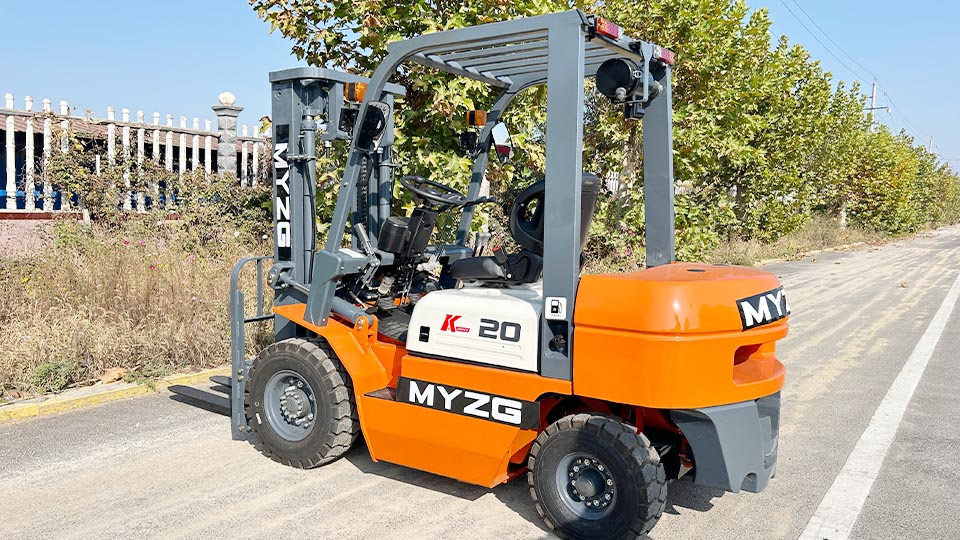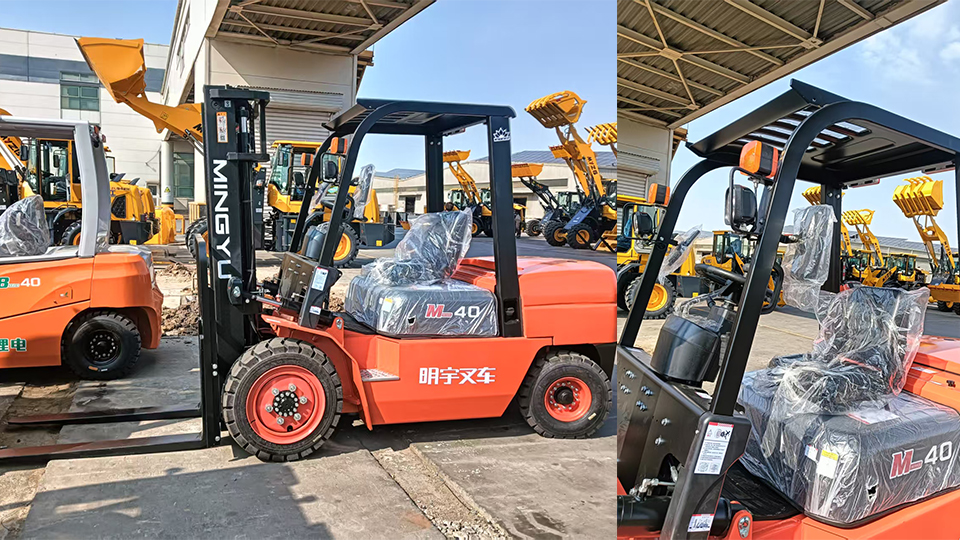
Abstract
Forklift forks, often referred to as tines, are the single most critical load-bearing and handling components of a lift truck. Their primary function necessitates a material science paradigm that balances immense tensile and yield strength, exceptional impact toughness, high resistance to abrasion, and good weldability for the attachment of carriage hooks. This technical article delves into the metallurgic composition, manufacturing processes, heat treatments, and international standards that define the integrity and performance of forklift forks. The overwhelming majority of modern, high-performance forks are fabricated from proprietary formulations of high-strength, low-alloy (HSLA) steel, with specific emphasis on grades such as the quenched and tempered (Q&T) alloy steels (e.g., variations of ASTM A514 and specialized Carbon-Boron Steels) designed to meet the rigorous demands of ISO 2330 and FEM/ISO mounting specifications.

1. Introduction: The Functional and Structural Demands
The design and material selection for a forklift fork are driven by a singular, non-negotiable requirement: safety under extreme cyclic loading. A fork operates essentially as a cantilever beam, enduring massive bending moments concentrated at the heel—the transition point between the vertical shank and the horizontal blade—when carrying a load at its designated load center. This necessitates a material with a high minimum yield strength (σ y), which is the stress level at which the material begins to plastically deform. Permanent deformation, even on a microscopic scale, is a failure criterion for a fork, as it compromises the angle of the blade and the overall structural geometry.
Beyond static strength, forklift forks are subjected to:
Fatigue Loading: The repeated cycles of lifting, lowering, and traversing with a load, often exceeding one million cycles at over 125% of the nominal capacity during compliance testing (ISO 2330).
High Impact and Abrasion: Frequent contact with pallets, racks, and the floor leads to concentrated impact stresses and surface wear.
Low-Temperature Impact Toughness: For operations in cold storage or external environments, the material must retain sufficient energy absorption capacity to prevent brittle fracture at temperatures as low as −20 C.
The core of forklift fork metallurgy is the selection of an alloy that can simultaneously satisfy these demanding mechanical properties.
2. The Dominant Material: High-Strength Low-Alloy Steel
The material of choice for industrial-grade forklift forks is almost universally a high-strength, low-alloy (HSLA) steel, often referred to as specialized "fork steel." These alloys are distinguished from standard carbon structural steels (like A36 or S235) by the precise addition of minor alloying elements and a critical thermal processing regimen.
2.1. Chemical Composition and Alloying Elements
The specific chemical compositions are often proprietary to manufacturers, but they adhere to a family of steels that balance strength and processability. Key alloying elements and their functions include:
Element Typical Concentration (wt%) Primary Metallurgical Function
Carbon (C) 0.15−0.35 Primary hardener; essential for martensite formation during quenching. Must be controlled for weldability.
Manganese (Mn) 0.70−1.50 Increases hardenability, strength, and toughness; serves as a deoxidizer.
Chromium (Cr) 0.40−1.50 Increases hardenability; improves high-temperature strength and corrosion resistance (though not to stainless levels).
Molybdenum (Mo) 0.15−0.60 Enhances hardenability and strength, particularly at elevated temperatures; resists temper embrittlement.
Silicon (Si) 0.15−0.45 Deoxidizer; modest strengthening effect in solid solution.
Boron (B) ∼0.0005−0.005 Micro-alloying element; dramatically increases hardenability with minimal impact on weldability. Common in specialized fork steels.
Titanium/Vanadium (Ti/V) <0.10 Micro-alloying elements that act as grain refiners, enhancing toughness and fatigue life.
A common representative of this family in heavy-duty applications is a Quenched and Tempered (Q&T) plate steel, such as a derivative of ASTM A514 (often called T-1 steel). This grade is renowned for its minimum yield strength of approximately 690 MPa (100,000 psi) and high toughness, making it suitable for demanding structural components like crane booms and, by extension, high-capacity forklift forks. Another frequently cited fork steel composition is 33MnCrTiB, a high-strength, low-alloy steel specifically developed for this application, incorporating manganese, chromium, titanium, and boron.
2.2. Mechanical Property Requirements
The chosen steel must exhibit superior mechanical properties, far exceeding those of standard mild steel:
High Yield Strength (σ y ): A minimum yield strength in the range of 690 MPa is typical for high-grade forks. This high value ensures the fork maintains its original geometry under maximum rated load, preventing permanent set or "fork droop."
Ultimate Tensile Strength (σ UTS): Generally in the range of 800−950 MPa.
Toughness: Measured by the Charpy V-Notch (CVN) impact test, typically at −20
∘ C. ISO 2330 specifies a minimum impact resistance value (e.g., 27 Joules) to guarantee the fork's ability to absorb energy from sudden impacts without fracturing.
Hardness: A controlled surface hardness (often in the range of 235−300 HBW Brinell) is necessary to resist surface abrasion and wear at the blade tip and bottom face.
3. Manufacturing Process: From Billet to Finished Fork
The fabrication of a forklift fork is a highly specialized process, moving through several critical stages to transform the raw steel billet into a certified component.

3.1. Material Shaping: Forging and Hot Rolling
The raw material is typically a rectangular steel billet. The shaping process is accomplished through:
Hot Rolling: The billet is heated and passed through a series of rolls to achieve the required cross-section for the shank and blade. This process imparts a desirable grain flow, which is beneficial for the material's mechanical strength and resistance to fatigue.
Forging (Upsetting and Bending): The most crucial and characteristic step is the formation of the heel. The heated steel bar is subjected to a massive compressive force (upsetting) and then bent to form the 90-degree angle connecting the shank and blade. Forging at the heel concentrates the material's grain structure, providing maximum strength at the area of highest stress concentration. The tip of the blade is often tapered or chiseled during the forging process.
3.2. Critical Step: Quenching and Tempering (Q&T)
The desired combination of high strength, hardness, and toughness is not achievable solely through alloying; it requires a precise heat treatment. The Quench and Temper (Q&T) process is foundational to fork production:
Austenitizing/Quenching: The fork is heated to a high temperature (∼850
∘
C−950
∘
C) to form austenite. It is then rapidly cooled (quenched) in a medium like oil or water. This rapid cooling transforms the microstructure into the extremely hard, but brittle, phase known as martensite.
Tempering: The now-martensitic fork is reheated to an intermediate temperature (∼500
∘
C−650
∘
C) and held for a specified time before a final, controlled cooling. This step reduces the brittleness of the martensite while maintaining the majority of its strength and significantly improving ductility and impact toughness. The final microstructure is typically tempered martensite or fine sorbite.
This Q&T process is vital for meeting the high yield strength and low-temperature toughness requirements mandated by international standards.
3.3. Finishing and Welding
The final stages involve:
Welding: The suspension elements (the top and bottom hooks for ITA/FEM mounting) are typically welded onto the vertical shank. This requires the base fork material to possess good weldability (low Carbon Equivalent value) and the welding procedure to be strictly controlled, often involving pre-heating and post-weld heat treatment in the local area to mitigate the formation of brittle heat-affected zones (HAZ) and to relieve residual stresses.
Machining and Finishing: Shot blasting, machining of critical surfaces (like the hook faces), and painting (except for the load-bearing faces) complete the process.
4. International Standards and Quality Control
The materials and manufacturing processes are strictly governed by international standards to ensure interchangeability, safety, and performance.
4.1. Key Standards
ISO 2328: Specifies the mounting dimensions for hook-on type fork arms and carriages (the FEM/ITA classification system, e.g., Class 2, 3, 4). This standard ensures a fork will correctly fit a corresponding lift truck carriage.
ISO 2330: This is the most crucial standard regarding material quality and testing. It specifies the technical characteristics, manufacturing, and testing requirements for solid-section fork arms. Compliance with this standard requires rigorous type testing, including:
Static Yield Test: Loading a sample fork to a minimum safety factor (e.g., three times the nominal capacity for forks under 5500 kg) to ensure no permanent deformation.
Fatigue Test: Subjecting a sample fork to one million cycles at a 25% overload (1.25 times the nominal capacity) without failure or cracking.
Impact Test: CVN testing at −20
∘
C on cross-sections taken from the fork material.
4.2. Quality Assurance
Manufacturers maintain stringent quality control, including:
Raw Material Certification: Traceability and chemical composition verification of the initial steel billet.
Non-Destructive Testing (NDT): Magnetic Particle Inspection (MPI) or dye penetrant inspection on the critical heel area of every finished fork to check for surface and near-surface cracks introduced during forging, bending, or heat treatment.
Hardness Testing: Verification of the final tempered hardness to ensure the mechanical properties meet specifications.
5. Conclusion: Engineered for Extreme Duty
The forklift fork is a marvel of materials engineering, a seemingly simple component whose reliability is a direct result of precise metallurgic selection and complex thermal-mechanical processing. It is not merely a piece of mild steel, but a high-performance, quenched and tempered high-strength low-alloy steel, meticulously engineered with minor percentages of elements like Manganese, Chromium, Molybdenum, and Boron. This carefully controlled chemistry, combined with the rigorous forging and heat treatment, provides the unparalleled yield strength, fatigue resistance, and toughness required to safely move multi-ton loads in the demanding industrial environment. Adherence to standards like ISO 2330 ensures that the "metal of mettle" that constitutes a forklift fork provides a critical layer of safety and durability in material handling operations worldwide.
Name: selena
Mobile:+86-13176910558
Tel:+86-0535-2090977
Whatsapp:8613181602336
Email:vip@mingyuforklift.com
Add:Xiaqiu Town, Laizhou, Yantai City, Shandong Province, China